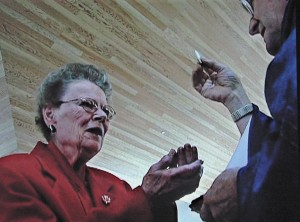Closure follows Angela Tucker’s search for her birth parents. A transracial adoptee, Angela is a black woman born in the American South who was adopted in infancy and raised by white parents in Bellingham, Washington. Compiled from home recordings captured by Angela’s husband Bryan Tucker [also labeled as the film’s director and producer], the documentary explores the dynamics of transracialism throughout Angela’s journey to find and reconnect with her birth parents. The film primarily features Angela and Bryan through their production of the documentary and their quest to locate Angela’s birth parents. Also featured are Angela’s adopted parents who have one biological child in addition to seven adopted children including Angela.
Beginning with an initial framing that emphasizes Angela’s growing curiosity of her biological background, we learn that Angela is a college graduate in her mid 20s living near where she was raised in Washington. Her search begins with a single piece of information: the first name of her father. After exhaustive Internet searching, Angela is able to identify who she believes to be her father: a street performer in Chattanooga, Tennessee. This discovery prompts Angela, Bryan and her birth family to travel to the South to meet the man in person. This leads to a formal blood test, a series of introductions and reunions with extended family and a complicated citywide search for her birth mother, which all ultimately end successfully.
As the documentary, skillfully crafted from a wealth of Bryan’s personal camcorder files, only superficially attempts to address issues of transracialism, the story fundamentally becomes a meditation on notions of family as supposed to racial identity. While Angela’s adopted family does very little by way of acknowledging discrimination or racism in their raising of a black child, Angela does share anecdotes of feeling as if she didn’t fit in when she was the only black girl in elementary school, and of her childhood desire for someone to comment on her similarity in appearance to her parents. Despite this, the film is generally not interested in questioning whether Angela’s upbringing was problematic or whether her entire white family descending upon her black working class relatives in Tennessee is controversial. The film’s primary concern is offering context to instances of adoption while expanding our perception of what a family is.
https://www.adoptivefamilies.com/openness/birth-family-search-angela-tucker-closure-documentary/
http://www.law.harvard.edu/students/orgs/blj/vol20/morrison.pdf






